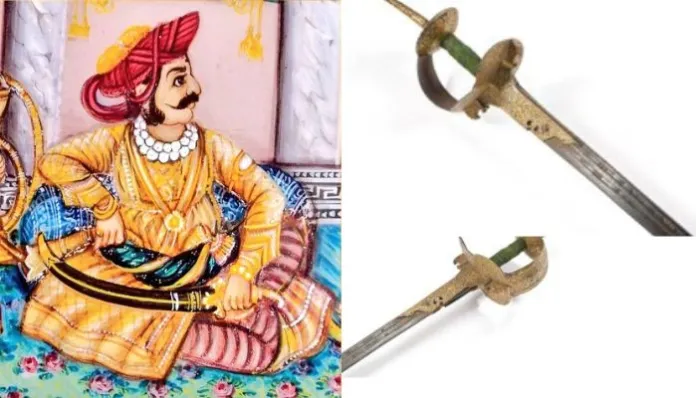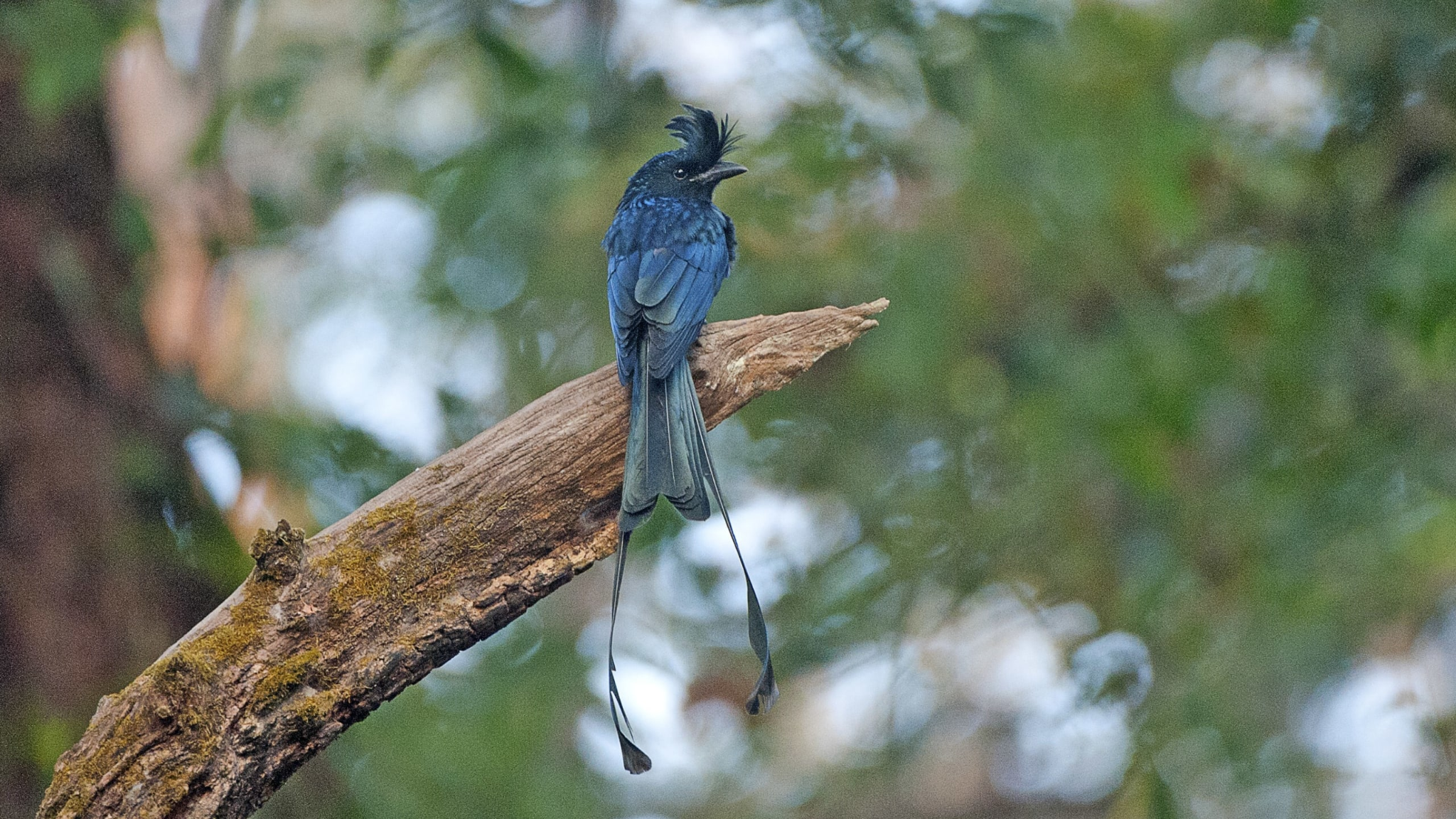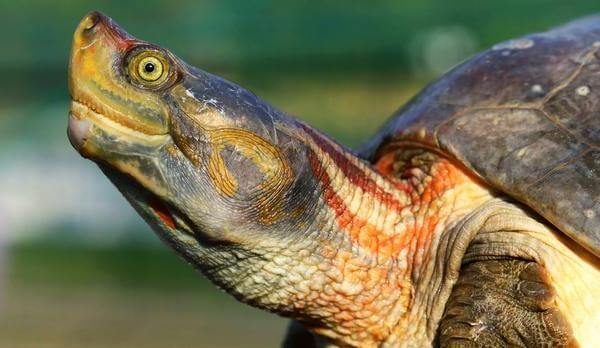Maharashtra Switch to Hindi
Iconic Sword of Raghuji Bhosale I
Why in News?
The Maharashtra government has successfully reclaimed the iconic sword of legendary Maratha warrior Raghuji Bhosale I, at an auction conducted by Sotheby’s in London.
Key Points
- Historic Achievement by Maharashtra:
- The reclaimed item is the 18th-century sword of Raghuji Bhosale I, a legendary Maratha general and founder of the Nagpur-based Bhosale dynasty.
- Raje Mudhoji Bhosale of the Nagpur royal family welcomed the move and praised the timely intervention of both state and central authorities.
- Officials confirmed that the sword will soon return to India and is expected to be displayed in a museum or heritage centre.
- Legacy of Raghuji Bhosale I:
- Raghuji Bhosale I (1695–1755) served as a prominent general under Chhatrapati Shahu Maharaj.
- He earned the title ‘Senasaheb Subha’ for his military prowess.
- He led major campaigns in Bengal (1745 and 1755), expanding Maratha control into Bengal and Odisha.
- Raghuji also extended his influence into Chanda, Chhattisgarh, and Sambalpur.
- His victories in South India, including over the Nawabs of Kurnool and Cuddapah, helped solidify Maratha dominance.
- Historical and Artistic Value of the Sword:
- The reclaimed sword is an example of the ‘firangi’ style — featuring a straight, European blade combined with a locally crafted Mulheri hilt.
- The hilt is intricately decorated with koftgiri gold inlay and wrapped in green cloth.
- An inscription in Devanagari reads: “Shrimant Raghoji Bhosale Senasaheb Subha Firang”, suggesting the sword belonged to or was custom-made for Raghuji Bhosale.
- The European blade bears a manufacturer’s mark, highlighting the global arms trade and Indo-European fusion of the 18th century.
- Possible Historical Origins of the Sword:
- Experts speculate the sword may have been part of the loot seized by the British after the 1817 Battle of Sitabuldi, where the East India Company defeated the Nagpur Bhosales.
- It may also have been gifted to the British in the aftermath of the battle.
Nagpur Bhosales
- The Nagpur branch of the Bhonsle dynasty was established by Raghoji Bhonsle I in the early 18th century.
- Under Raghoji’s leadership, Maratha influence spread across central and eastern India, including parts of modern-day Madhya Pradesh, Chhattisgarh, Jharkhand, and Odisha.
- The Nagpur Bhonsles identified themselves as Kshatriyas and traced their ancestry to the Sisodia Rajputs of Udaipur, highlighting their royal heritage.
- The family earned the title "Hinganikar" because an ancestor—likely a contemporary of Maloji Bhonsle (grandfather of Chhatrapati Shivaji Maharaj)—rehabilitated the village of Beradi near Hingani in present-day Pune.
- The Nagpur Bhonsles ruled over a region rich in iron and copper, materials that were expertly used to produce both everyday tools and high-quality weaponry.
- The weapons manufactured under the Bhonsles were celebrated for their superior craftsmanship, artistry, and functional design—reflecting a blend of martial skill and aesthetic excellence.


Maharashtra Switch to Hindi
Maharashtra 65th Foundation Day
Why in News?
Maharashtra celebrated its 65th Foundation Day on 1st May 2025 with grand events across the State, showcasing its rich cultural, historical, and social legacy.
Key Points
- Historical Significance of Maharashtra Day:
- Pre- Independence:
- Before independence, present-day Maharashtra and Gujarat were part of the Bombay Presidency—a large British administrative region with diverse linguistic and cultural communities.
- Post-Independence:
- After India gained independence in 1947, the Bombay Presidency was reorganized into Bombay State.
- The new state included both Marathi and Gujarati-speaking populations, leading to rising linguistic tensions over time.
- Marathi-speaking citizens launched the Samyukta Maharashtra Samiti, demanding a separate state for Marathi speakers.
- The Gujarati-speaking community began advocating for the formation of a separate state of Gujarat.
- Fazal Ali Commission:
- In 1953, the Central Government appointed the Fazal Ali Commission to examine state boundaries and recommend reorganization.
- Based on the Commission’s report, the States Reorganisation Act, 1956 was enacted.
- However, Bombay State remained undivided, leading to further discontent as it was not reorganized on a linguistic basis.
- The United Maharashtra Movement (Samyukta Maharashtra Andolan) gained widespread support and witnessed several instances of protest and martyrdom.
- Formation of Maharashtra and Gujarat:
- Responding to mass movements, the Central Government passed the Bombay Reorganisation Act, 1960.
- On 1 May 1960, Bombay State was officially divided into two separate states:
- Maharashtra for Marathi and Konkani-speaking people.
- Gujarat for Gujarati and Kutchi-speaking communities.
- Significance of the Reorganisation:
- The formation of Maharashtra and Gujarat provided constitutional recognition to linguistic identity in India.
- It set a precedent for future state formations based on language and cultural cohesion.
- Pre- Independence:
- State-Level Celebrations:
- The state Chief Minister Devendra Fadnavis paid homage to martyrs of the Samyukta Maharashtra Movement at Hutatma Chowk in Mumbai.
- He reiterated the State’s vision of becoming a trillion-dollar economy, drawing inspiration from figures like Chhatrapati Shivaji Maharaj and Dr. B.R. Ambedkar.
- CM announced a new 100-day development initiative aimed at accelerating infrastructure growth and strengthening the State’s economy.
- He also announced a Cabinet-approved policy to develop Maharashtra’s shipbuilding, shipbreaking, and ship repair sectors.
- The policy aims to build a robust industrial ecosystem, boost economic growth, and generate substantial employment.
- In Mumbai, Governor C.P. Radhakrishnan and former Governor Ramesh Bais participated in ceremonial events, paying tributes to Maharashtra’s historical icons including Shivaji Maharaj, B.G. Tilak, V.D. Savarkar, Jyotirao and Savitribai Phule, and Dr. Ambedkar.
- The state Chief Minister Devendra Fadnavis paid homage to martyrs of the Samyukta Maharashtra Movement at Hutatma Chowk in Mumbai.


Haryana Switch to Hindi
Greater Racket-Tailed Drongo
Why in News?
A greater racket-tailed drongo (Dicrurus paradiseus) was spotted in Jhanjhrola, Gurugram marking the bird’s first recorded sighting in the district.
Key Points
- About Greater Racket-tailed Drongo:
- Appearance:
- A medium-sized bird native to Asia, notable for its elongated outer tail feathers with webbing only at the tips.
- Diurnal in nature but remains active before dawn and after dusk.
- Vocal Abilities:
- Known for producing a variety of loud calls, including accurate imitations of other bird species.
- Distribution in India:
- Found from the western to eastern Himalayas, including the Mishmi Hills.
- It also inhabits hilly regions of peninsular India and the Western Ghats.
- Conservation Status:
- IUCN Red List Status: Least Concern
- Wildlife Protection Act, 1972: Schedule IV
- Migratory Pattern:
- The species is usually found in moist, dense forests along the Himalayan foothills and terai regions.
- It rarely descends to lower elevations, except marginally during snowfall in the higher ranges.
- It is an altitudinal migrant, not commonly seen in the National Capital Region (NCR).
- Appearance:
IUCN Red List
- The IUCN Red List is the foremost global resource for assessing the risk of extinction among animals, fungi, and plant species.
- Accessible to all, it serves as a crucial indicator of global biodiversity health, it offers comprehensive insights into species' characteristics, threats, and conservation measures, playing a pivotal role in shaping informed conservation decisions and policies.
- The IUCN Red List Categories define the extinction risk of species assessed. Nine categories extend from NE (Not Evaluated) to EX (Extinct). Critically Endangered (CR), Endangered (EN) and Vulnerable (VU) species are considered to be threatened with extinction.
- It is also a key indicator for the Sustainable Development Goals and Aichi Targets.
- The IUCN Red List includes the IUCN Green Status of Species, which assesses the recovery of species’ populations and measures their conservation success.
- There are eight Green Status Categories: Extinct in the Wild, Critically Depleted, Largely Depleted, Moderately Depleted, Slightly Depleted, Fully Recovered, Non-Depleted and Indeterminate.
- A Green Status assessment examines how conservation actions have affected the current Red List status.
Uttar Pradesh Switch to Hindi
Night Landing Airstrip in UP
Why in News?
The 3.5 kilometre stretch of the Ganga Expressway in Shahjahanpur, Uttar Pradesh will be the first expressway in the country where Indian Air Force fighter planes will be able to land at night.
Key Points
- About Ganga Expressway :
- Ganga Expressway is the second longest expressway in the country after Mumbai-Nagpur Expressway.
- It is an ambitious initiative with an estimated length of 594 kilometres.
- Connecting the state from east to west, this expressway will pass through 518 villages in 12 districts, significantly reducing the travel time between Meerut and Prayagraj.
- Strategic Approach:
- Uttar Pradesh now has three such expressways where landing facility for fighter jets is available - Lucknow-Agra Expressway , Purvanchal Expressway and Ganga Expressway.
- This is the first time that state-of-the-art fighter aircraft like Rafale, Mirage and Jaguar will land at night on an expressway in India .
- This airstrip will serve as an alternate runway for the Indian Air Force in case of war or disaster.
Rafale
- Rafale is a French twin-engine and multirole fighter aircraft, designed by Dassault Aviation of France.
- State-of-the-art technology has been used in this fighter plane and it is a 4.5 Generation fighter plane.
- The Meteor Missile, SCALP Cruise Missile and MICA Missile System present in the Rafale fighter aircraft make it very important from the security point of view.
- Rafale can fly at a speed of 2,222.6 kilometres per hour and an altitude of 50,000 feet.
- This fighter aircraft is approximately 15.27 metres long and can carry 9,500 kilograms of bombs and ammunition at a time.
Jaguar
- The Jaguar is a versatile aircraft used for ground attack, air defense, and reconnaissance missions.
- It is a Fifth-generation (5G) fighter aircraft capable of operating in heavily contested combat zones, characterised by the presence of the most advanced air and ground threats, both current and anticipated.
- 5G fighter jets have stealth capabilities and can cruise at supersonic speeds without engaging afterburners.
- It stands out from fourth-generation (4G) peers due to its multi-spectral low-observable design, self-protection, radar jamming capabilities, and integrated avionics.
- The squadrons of MiG-21s, MiG-29s, Jaguars, and Mirage 2000s are scheduled to be phased out by the middle of the next decade.
Uttar Pradesh Switch to Hindi
Red Crowned Roofed Turtle
Why in News?
The Red Crowned Roofed Turtle has returned to the Ganga River after an absence of three decades .
- This success is a historic biodiversity conservation achievement under the Namami Gange Mission and the Turtle Survival Alliance India (TSAFI) project.
Key Points
- About the Red Crowned Roofed Turtle:
- Scientific name: Batagur kachuga.
- Common Names: Bengal Roof Turtle, Red Crowned Roofed Turtle.
- About:
- The Red Crown Roofed Turtle is one of the 24 species endemic to India , the males of which are characterized by bright colours like red, yellow, white and blue on the face and neck.
- Distribution:
- It is a freshwater turtle species found in deep-flowing rivers with nesting sites.
- Historically the species was widespread in the Ganges River in both India and Bangladesh. It is also found in the Brahmaputra basin.
- Currently the National Chambal River Gharial Sanctuary in India is the only area that has a significant population of the species, but this protected area and habitat are also now under threat.
- Large coastal and riverine projects disrupt river flow and increase water pollution.
- Subpopulations suffer due to entanglement in fishing nets and disturbances from human activity.
- Pollution, irrigation-related water extraction, and unregulated dam flows degrade natural habitats.
- Sand bar habitats used for hunting are shrinking due to increased mining and seasonal agriculture along the Ganga River.
- Overharvesting for illegal consumption and international wildlife trade poses a serious threat.
- Protection Status:
- International Union for Conservation of Nature (IUCN) Red List : Critically Endangered
- Wildlife Protection Act (WPA), 1972: Schedule I
- CITES : Appendix II
- Rehabilitation
- The turtles were released in the Haiderpur wetland in Uttar Pradesh . This area is located along the river Ganga and its ecosystem was considered suitable for the rehabilitation of turtles.
- The turtles were divided into two groups – one was released in the upper part of the Ganga Barrage and the other in the lower part.
- Each turtle is fitted with a tracking device to monitor their movements and adaptation to the environment.
- The turtles were released in the Haiderpur wetland in Uttar Pradesh . This area is located along the river Ganga and its ecosystem was considered suitable for the rehabilitation of turtles.
Turtle Survival Alliance India (TSAFI)
- TSAFI represents the Indian chapter of the global Turtle Survival Alliance, which is committed to protecting freshwater turtles and tortoises worldwide.
- It works to safeguard turtles and tortoises from major threats such as habitat destruction, illegal wildlife trade, and the impacts of climate change.
- The organisation undertakes diverse initiatives, including:
- Scientific research on turtle species and habitats
- On-ground conservation projects
- Public education and awareness campaigns
- TSAFI aims to ensure the long-term survival of turtle species in India by combining community involvement with scientific expertise.
National Chambal Sanctuary
- The National Chambal Sanctuary, located at the trijunction of Rajasthan, Madhya Pradesh, and Uttar Pradesh.
- It is a fragile lotic ecosystem, which is a critically important breeding ground for gharials - fish-eating crocodiles.
- The sanctuary is protected under the Wildlife Protection Act, 1972, and is listed as an ‘Important Bird and Biodiversity Area’.
- The sanctuary is also a proposed Ramsar site, and over 320 species of resident and migratory birds inhabit the area.
Namami Gange Programme
- Namami Gange Programme is an integrated conservation mission, approved by the Central Government in June 2014 as a 'Flagship Programme' to achieve the twin objectives of effective abatement of pollution and conservation and rejuvenation of the National River Ganga.
- It is being operated under the Ministry of Water Resources, Department of River Development and Ganga Rejuvenation and Ministry of Jal Shakti .
- In the second phase of Namami Gange Programme (2021-26), the states will focus on speedy completion of projects and preparation of credible Detailed Project Reports (DPRs) for projects in Ganga tributary towns.
- Attention is also being paid to the revival of small rivers and wetlands.
Bihar Switch to Hindi
Development Projects Inaugurated in Bihar
Why in News?
The Prime Minister of India inaugurated and laid the foundation stone of various development projects in Madhubani, Bihar.
Key Points
- Rail Connectivity and Projects:
- The Prime Minister launched several important projects to boost rail connectivity.
- Amrit Bharat Express between Saharsa and Mumbai , Namo Bharat Rapid Train between Jaynagar and Patna and trains between Pipra, Saharsa and Samastipur were flagged off. Along with this, new railway lines and bridges were inaugurated in Bihar.
- This will provide better transportation facilities in various parts of the state and promote socio-economic development.
- The Prime Minister launched several important projects to boost rail connectivity.
- Power Projects:
- The foundation stone of projects worth Rs 1,170 crore was laid to strengthen the power infrastructure in Bihar.
- Several projects worth more than Rs 5,030 crore were also inaugurated under the Restructured Distribution Area Scheme.
- This will improve power supply in rural and urban areas and give a new direction to development.
- Prime Minister Housing Scheme:
- Under this scheme , more than one lakh beneficiaries took home the house warming ceremony and keys were handed over to more than 54,000 beneficiaries.
- Assistance to Self Help Groups:
- Under Deendayal Antyodaya Yojana – National Rural Livelihoods Mission (DAY-NRLM), assistance amount of about Rs 930 crore was distributed to more than two lakh self-help groups of Bihar under the Community Investment Fund.
Pradhan Mantri Awas Yojana-Gramin (PMAY-G)
- Launch: To achieve the objective of “Housing for All” , the erstwhile rural housing scheme Indira Awas Yojana (IAY) was restructured into Pradhan Mantri Awas Yojana-Gramin (PMAY-G) as a Centrally Sponsored Scheme from 1 April 2016 .
- Concerned Ministry: Ministry of Rural Development.
- Objective: To provide assistance to rural people living below poverty line (BPL) for construction of housing units and upgradation of existing unusable kutcha houses by providing full subsidy.
- Beneficiaries: Scheduled Castes/Scheduled Tribes, freed bonded labourers and persons belonging to non-SC/ST categories , widows or next of kin of defence personnel killed in war, ex-servicemen and retired members of paramilitary forces, persons with disabilities and minorities.
- Selection of Beneficiaries: Through three-step verification like Socio-Economic Caste Census 2011 , Gram Sabha and Geo-tagging .
- Cost Sharing: The Centre and the States share the cost in the ratio of 60:40 in case of plain areas and 90:10 in case of North Eastern States, two Himalayan States and the Union Territory of Jammu & Kashmir .
- In case of other Union Territories including Union Territory of Ladakh, the Centre bears 100% of the cost .
Pradhan Mantri Awas Yojana – Urban (PMAY-U)
- Launch: Launched on 25 June 2015, the scheme aimed to provide housing for all in urban areas by the year 2022.
- Concerned Ministry: Ministry of Housing and Urban Affairs
- Status: A total of 118.64 lakh houses have been sanctioned and more than 88.02 lakh houses have been completed/delivered to the beneficiaries.
- features:
- To address the urban housing shortage among the urban poor including slum dwellers by ensuring pucca houses to the eligible urban poor.
- The Mission covers the entire urban area, including statutory towns , notified planning areas, development authorities, special area development authorities , industrial development authorities or authorities entrusted with the function of urban planning and regulation under State legislation.
- The Mission promotes women empowerment by providing ownership of houses in the name of women members or in joint names.
Rajasthan Switch to Hindi
Malaria Elimination in Rajasthan
Why in News?
On the occasion of World Malaria Day 2025 , Rajasthan has been included in Category-1 for malaria elimination at the national level.
Key Points
- Drastic Drop in Malaria cases :
- Rajasthan has emerged as one of the leading states in malaria elimination, due to its effective strategies and innovative measures to combat seasonal diseases like malaria, dengue, and chikungunya.
- According to the State Public Health Director, while 2213 malaria cases were reported in 2024, only 59 cases have been reported so far in 2025 .
- Success of Public Awareness Campaign :
- Under IEC activities (Information, Education, Communication), the general public was made aware through means like larva demonstration, audio-video publicity , pamphlets and posters, which strengthened the prevention of the disease.
- Anti-larval spraying, focal spraying, fogging and source reduction activities were carried out across the state from 1 April 2025. The program was effective in both urban and rural areas.
- Special Attention in High Risk Districts :
- Indoor Residual Spray (IRS) was carried out in two phases in 9 high-risk districts namely Alwar, Balotra, Barmer, Bikaner, Jaisalmer, Pratapgarh, Salumber, Sriganganagar and Udaipur to control the sources of infection.
Malaria
- Malaria is a deadly disease caused by the Plasmodium parasite , which is spread by the bite of infected female Anopheles mosquitoes.
- There are five species of Plasmodium parasites that cause malaria in humans, and two of these parasite species (P. Falciparum and P Vivax) are more dangerous.
- Malaria is mainly found in tropical and subtropical regions of Africa, South America and Asia .
- When a mosquito bites an infected person, it also becomes infected. The person who is bitten by this mosquito gets malaria parasites in his body. After reaching the liver, the parasites develop and infect the red blood cells .
- Fever and flu-like symptoms, such as chills, headache, muscle aches and fatigue, are symptoms of malaria. It is worth noting that malaria is treatable and can be prevented.
World Malaria Day
- It is celebrated every year on April 25. It was established in 2007 by the World Health Organization (WHO) to raise awareness about malaria and take action to eradicate it.
- The theme of World Malaria Day 2025 is “Malaria Ends with Us: Reinvest, Reimagine, Reignite”.


.png)








.png)


.jpg)



 PCS Parikshan
PCS Parikshan

.jpg)
.jpg)

.jpg)
.jpg)
.jpg)



